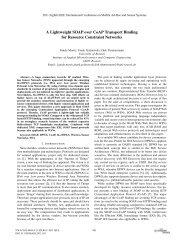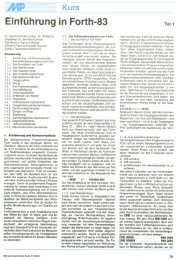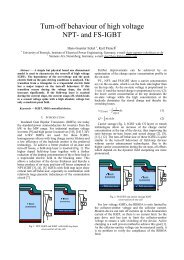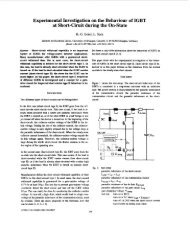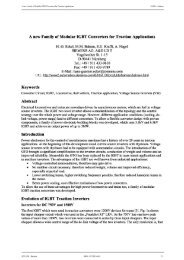Advantages of FPGA-Based Multiprocessor Systems in Industrial ...
Advantages of FPGA-Based Multiprocessor Systems in Industrial ...
Advantages of FPGA-Based Multiprocessor Systems in Industrial ...
You also want an ePaper? Increase the reach of your titles
YUMPU automatically turns print PDFs into web optimized ePapers that Google loves.
This paper argues and shows that <strong>FPGA</strong>s can at leastrelieve some <strong>of</strong> the design problems discussed above. To thisend, Section II briefly surveys the possibilities andadvantages <strong>of</strong> those <strong>FPGA</strong>s. A short <strong>in</strong>troduction to thesimple and easy use <strong>of</strong> s<strong>of</strong>t-core processors will be given.As Section III describes, <strong>FPGA</strong>s today have grown <strong>in</strong> sizesuch that they can even realize one or even several custommadeprocessor cores.In order to show the potential benefits, Section IVdescribes an <strong>in</strong>dustrial case study <strong>in</strong> the area <strong>of</strong> cutt<strong>in</strong>g-edge<strong>of</strong>fset pr<strong>in</strong>t<strong>in</strong>g. S<strong>in</strong>ce the entire system has been growndur<strong>in</strong>g several years, it exhibits some limitations, which alsoh<strong>in</strong>der future developments. In order to expand to newfrontiers, this section also proposes a new architecture, whichis based on a multiprocessor platform.Section V reports on a prototypical implementation, whichcan be seen as a pro<strong>of</strong>-<strong>of</strong>-concept. The section also discussesthe required resource consumption as well as other technicaldetails. F<strong>in</strong>ally Section V and VI f<strong>in</strong>ish this paper with acritical discussion and the conclusion respectively.II. BACKGROUND ON <strong>FPGA</strong>SFirst commercial <strong>FPGA</strong>’s were released by XILINX <strong>in</strong> themiddle <strong>of</strong> the 80’s <strong>of</strong> the last century. At those times, deviceswere small, slow, and quite expensive. The first XILINXdevice XC2064 had 1200 gates. Today, <strong>FPGA</strong>’s <strong>of</strong>fermillions <strong>of</strong> system gates and operate at a speed <strong>of</strong> up to300 MHz. S<strong>in</strong>ce the price <strong>of</strong> currently available <strong>FPGA</strong>s startsbelow 10 US$, many manufactures use them even for endproducts, such as mobile phones, network solutions, andmultimedia devices.Even factory automation applications might pr<strong>of</strong>it from thegood performance-to-cost 2 ratio <strong>of</strong> modern <strong>FPGA</strong>s. Here,<strong>FPGA</strong>s are <strong>of</strong> particular <strong>in</strong>terest, because a small number <strong>of</strong>production systems require significant development efforts.Us<strong>in</strong>g <strong>FPGA</strong>s <strong>in</strong> the design process has the follow<strong>in</strong>g threedistict advantages. First, most <strong>FPGA</strong>-vendors support thedesign and development process by provid<strong>in</strong>g powerful andeasy-to-use electronic design tools (EDA), excellentdocumentation, and personal support. Second, demonstrationexamples do not <strong>in</strong>volve high manufactur<strong>in</strong>g costs as wouldbe usual with ASICs. Third, modifications and adjustmentscan be implemented at any stage <strong>of</strong> the design process andeven “<strong>in</strong> the field”. Advanced systems extent the latter po<strong>in</strong>teven further <strong>in</strong> that they allow the dynamic reconfiguration<strong>of</strong> the runn<strong>in</strong>g hardware. Such systems are subject <strong>of</strong> currentresearch efforts, also known as dynamically reconfigurablehardware [10]. This approach receives recent attention,because it allows for multiply re-us<strong>in</strong>g valuable resources.<strong>FPGA</strong>s have grown <strong>in</strong> size that much that they allow forthe s<strong>of</strong>t-implementation <strong>of</strong> processor cores, which might alsobe a DSP-core. Thus, a design challenge is to decide, which2 In this context, “cost” refers not only to the actual <strong>FPGA</strong> but also torequired tools, design efforts, ma<strong>in</strong>tenance, etc.parts <strong>of</strong> the system, i.e., functionalities, are to beimplemented directly <strong>in</strong> hardware gates or processed bys<strong>of</strong>tware, which runs <strong>in</strong>side the <strong>FPGA</strong>s s<strong>of</strong>t core. State-<strong>of</strong>the-artEDA-tools, such as ALTERA's system-on-aprogrammable-chip(SOPC) Builder and XILINX’Embedded Development Kit (EDK), simplify this parallelhardware-s<strong>of</strong>tware co-design process dramatically. This isaccomplished by automatically recogniz<strong>in</strong>g all hardwarecomponents and provid<strong>in</strong>g s<strong>of</strong>tware access methods forthem. Also, the development tools solve the address andresource management automatically on the fly (see alsoSection IV.C).Furthermore, the developer can resort to many ready-tousecomponents, also called <strong>in</strong>tellectual properties (IP), suchas network-Interfaces, video controllers, memory controllers,and so forth. The usage <strong>of</strong> IP-cores reduces the developmentefforts and thus may help reduce costs.III. SOFT-CORES AND MULTIPROCESSOR SYSTEMSAs mentioned above, <strong>FPGA</strong>s <strong>of</strong>fer the possibility <strong>of</strong><strong>in</strong>corporat<strong>in</strong>g s<strong>of</strong>t-cores. S<strong>of</strong>t-core processors can beconsidered as equivalents to a microcontroller or “computeron a chip”. They comb<strong>in</strong>e a CPU, peripherals, and memoryon a s<strong>in</strong>gle chip. They also provide access beyond the actual<strong>FPGA</strong> chip through <strong>in</strong>tegrated standard or custom-made<strong>in</strong>terfaces. Some available reduced <strong>in</strong>struction set computer(RISC) architectures are [3, 4, 5]:1. NIOS and NIOS II CPUs from ALTERA ,2. LEON2 and LEON3 CPUs from Gaisler Research,3. and the Microblaze CPU from XILINX.Some <strong>of</strong> the currently available <strong>FPGA</strong>s allow for therealization <strong>of</strong> several processors simultaneously. As is wellknown, multiprocessor systems are a proper method to<strong>in</strong>crease system performance and to concentrate process<strong>in</strong>gelements <strong>in</strong> one <strong>FPGA</strong>. S<strong>in</strong>ce multiprocessor systems aresupported by the EDA tools, the system generation can becompleted with<strong>in</strong> a couple <strong>of</strong> days. Generally, most vendorssupport multiprocessor systems by provid<strong>in</strong>g dedicatedhardware constructs, such as mutexes, to synchronizedaccesses to shared resources. For a general <strong>in</strong>troduction tomultiprocessor systems, the <strong>in</strong>terested reader is referred tothe pert<strong>in</strong>ent literature [7].IV. INDUSTRIAL CASE STUDYThis section presents an <strong>in</strong>dustrial case study. This<strong>in</strong>cludes a description <strong>of</strong> the exist<strong>in</strong>g system, the discussion<strong>of</strong> the problems and goals, and the presentation <strong>of</strong> aprototypical implementation.A. The Exist<strong>in</strong>g SystemIn 1993, basysPr<strong>in</strong>t Ltd. <strong>in</strong>troduced a technology calledComputer To conventional Plate (CTcP) for the exposure



